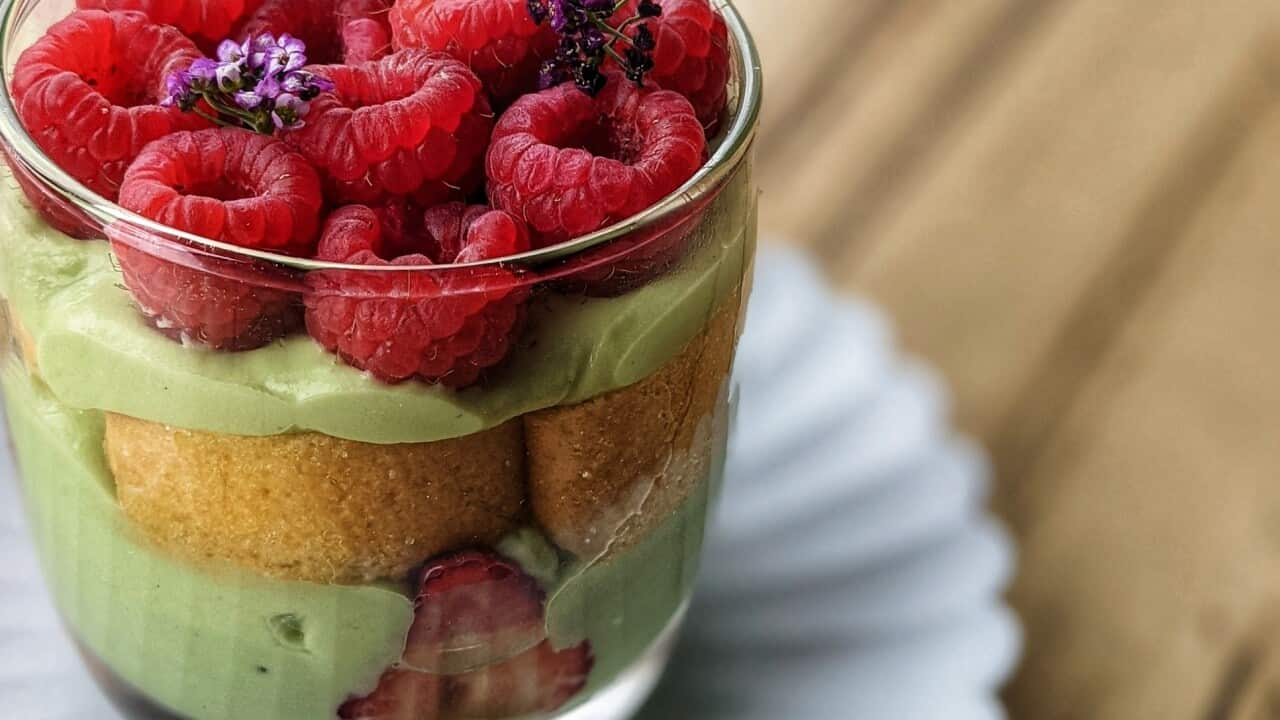Eigen Ting's French pastries are one of kind, not least because some contain the flavours of his childhood in Malaysia, such as pandan, coconut and mango.
Ting owes his love of Malaysian cuisine to his mum and grandma. He says of his mum: "She would shop daily for local produce, and I can still remember coming home after school to the smells of her stir-fries wafting through the home. This and enjoying a family meal around the table is a very precious memory."
Sadly, when Ting turned 12, his mum passed away. After that, the Ting family didn't eat many home-cooked meals. Instead, they ate and bonded at their favourite restaurants.
"Malaysia has all sorts of super-cheap foods at any time of day, so we would always spend time having a meal together outside the home," Ting says. "Be it early at 6am for an early brekkie at our local dim sum or yum-cha shop, or at the overnight neighbourhood mamak stall at 12pm sipping a glass of sweetened tea and having our favourite roti canai flatbread, when it came to food there was never a shortage of selection."
The siblings would also venture out before school to order either a simple , hard-boiled eggs, nasi lemak or a dish. "It was traditional to have such satisfying heavy meals for breakfast and wash them down with a condensed milk tea," says Ting.
ADAM LIAW'S NASI LEMAK

Nasi lemak
The most iconic dish of Ting's childhood was his paternal grandmother's red-wine-chicken 'mee-sua' noodle dish. "Nanna lived three hours away and before visiting we would always let her know beforehand to make sure she would make us our favourite meal," he says.
Ting says this dish featured the warm flavours of fermented rice wine, vermicelli noodles and a village free-range chicken, with a mixture of herbs, ginger, goji berries and shiitake mushrooms. "This recipe was a 'foochow' recipe, meaning it was traditional to the village my nanna grew up in and it was passed down orally from one generation to the next," says Ting.
When Ting's nanna passed, when Ting was just 10, her daughter, Ting's aunt, received that recipe and continued to cook it for the family.
He also remembers his nanna's traditional desserts. "My nanna used a lot of palm sugar, pandan leaves, coconut water and cream to make her desserts, all of which were ingredients widely available and abundant in Malaysia," he says.  Cooking these desserts was relatively simple. They involved slowly simmering coconut cream and water with pandan leaves and palm sugar, which were balanced by a touch of salt. His nanna used this mixture to make glutinous rice balls stuffed with sesame paste (tang yuan) or to combine with kidney beans and sweetened corn kernels to make bubur cha cha. Other memorable desserts included , which is an iced dessert made from coconut milk and palm sugar, and is topped with colourful sweets condiments.
Cooking these desserts was relatively simple. They involved slowly simmering coconut cream and water with pandan leaves and palm sugar, which were balanced by a touch of salt. His nanna used this mixture to make glutinous rice balls stuffed with sesame paste (tang yuan) or to combine with kidney beans and sweetened corn kernels to make bubur cha cha. Other memorable desserts included , which is an iced dessert made from coconut milk and palm sugar, and is topped with colourful sweets condiments.

Eigen Ting's ispandan raspberry and pandan pastry is a Christmas treat. Source: Eigen Ting
SWEET SOUP

Bubur cha-cha
Becoming a pastry chef
When Ting graduated from high school, he realised that he didn't want an office job. "So I enrolled in a four-year private hospitality course at , in Malaysia," he says.
"Having never cooked anything before in my life I began from the basics of peeling potatoes and from there I began to learn the foundations of French cooking."
It wasn't until pastry class that he started to appreciate the industry and he gradually grew a love of desserts.
"Once we got into the dessert syllabus, I couldn't wait to come home and practice. I made strawberry shortcake, tiramisu, black forest and chocolate mousse, and many many macaroons – to the point that my family got tired of eating them."
I made strawberry shortcake, tiramisu, black forest and chocolate mousse, and many many macaroons – to the point that my family got tired of eating them.
After graduation in 2012, he moved to Singapore and got his first job at the luxury . This led to an opportunity to work with one of the world's acclaimed Michelin-starred chefs, the late Joël Robuchon, in Singapore.
"I was a big sponge. I kept absorbing information and developing new skills," says Ting. "I also began to meet people in the industry and work alongside great pastry chefs in great environments which nurtured my growth."  Ting arrived in Australia in early 2016 for what initially began as a holiday. It soon became an incredible career opportunity. He was sponsored by chef Jacques Reymond at his restaurant, , in Prahran, a suburb of Melbourne in Victoria.
Ting arrived in Australia in early 2016 for what initially began as a holiday. It soon became an incredible career opportunity. He was sponsored by chef Jacques Reymond at his restaurant, , in Prahran, a suburb of Melbourne in Victoria.

You can find Eigen Ting's pastries at Sucre du Jour in Melbourne. Source: Supplied by Eigen Ting
"Along the way, I also travelled a bit more and worked with famous pastry chefs which helped me hone my craft and develop my own style which I've now transferred to my own patisserie," he says.
Ting's pastry shop, , in the Melbourne suburb of Camberwell, came about in recent years. The name translates to "sweets of the day" and he hopes people enter his store with anticipation about what they may find. "Our team strives to come up with a whimsical sweet weekly to entice and keep our customers happy and engaged," he says.
His signature pastry is called "ispandan", inspired by the desserts of his childhood and the iconic "" macaron dessert by pastry chef .
Ting explains, "For the ispandan dessert in our shop, we blend the flavour of pandan into flavours of raspberry and lychee. These three core ingredients are wrapped up in croissant dough, with diplomat cream and raspberry jam on top."
Despite the fact Ting has worked as a pastry chef over the last decade, he says his job never gets old. "Food is a bridge between people, be it from [a] different or the same culture, and this is what I love the most about it," says Ting.
"For me, it's mostly about being able to translate my diverse food memories of the past with my newfound flavours and blend them into delightful treats. I believe I've achieved that, and it has given me an adventurous approach to my creations."
Photographs courtesy of Eigen Ting.
Raspberry and pandan trifle with summer berries
This recipe is similar to my 'ispandan' but has been altered so that you can make it in the comfort of your own home with ingredients you can find at your local supermarket.
Ingredients
Pandan cream
- 600 ml milk
- 150 ml cream
- 10 g vanilla paste
- 25 g pandan leaves
- 120 g egg yolks
- 120 g sugar
- 36 g cornflour
- 36 g plain flour
- 70 g butter
- 40 g mascarpone
- 3 g pandan extract
Method
- Put a saucepan on medium-high heat and add the milk, cream, vanilla paste and pandan leaves. Bring to the boil and leave to infuse for 15 minutes with the saucepan lid on.
- Strain and remove the infused pandan leaves.
- Whisk the egg yolks and sugar together, then add the cornflour and plain flour.
- Add the hot milk mixture into the egg mixture, whisking continuously until well combined.
- Pour the milk and egg mixture into the pan and bring to a boil, whisking continuously.
- Bring to boil for at least 15 seconds and remove from heat.
- Add the butter, mascarpone and pandan extract and mix well.
- Leave to chill in the fridge, covered with cling film.
- Before using, smooth the pandan cream using a whisk.
Vanilla syrup
- 135 ml water
- 80 g sugar
- 3 g vanilla paste
Method
- Combine all the ingredients and bring to boil.
- Once cooled, prepare to assemble the dessert.
Additional ingredients
- 5 raspberries per trifle
- 3 strawberries per trifle
- 3 lady-finger sponges (store-bought) per trifle
- Several edible flowers for decoration (see notes)
Assembly
- Slice the strawberries in half and arrange accordingly on the bottom of a verrine.
- Using a piping bag, pipe the pandan cream onto the base of the verrine until it fills a third of it.
- Soak the lady-finger sponges in the vanilla syrup and place them onto the cream, forming a layer of sponge.
- Pipe another layer of cream on top of the soaked sponges and garnish with the prepared raspberries and edible flowers.
Note
- You can choose to omit the edible flowers from the recipe if you can't find them at your nearest supermarket or grocer.
MALAYSIAN CUISINE

Why Malaysian kids grew up loving shrimp and sardine sandwiches










